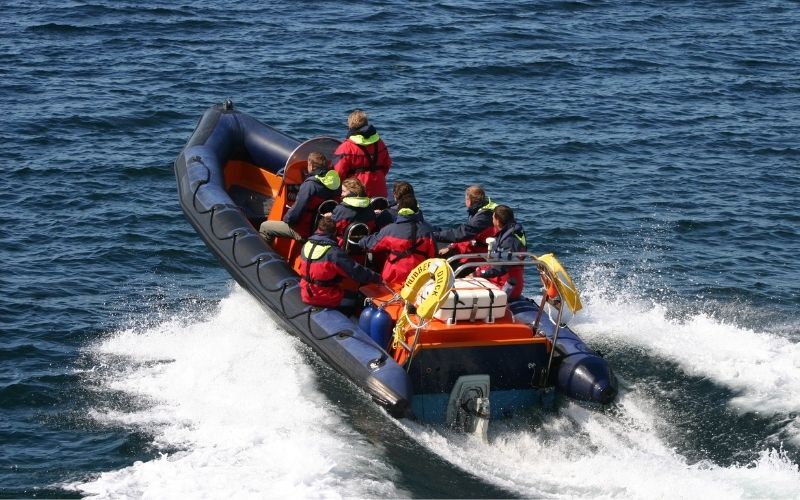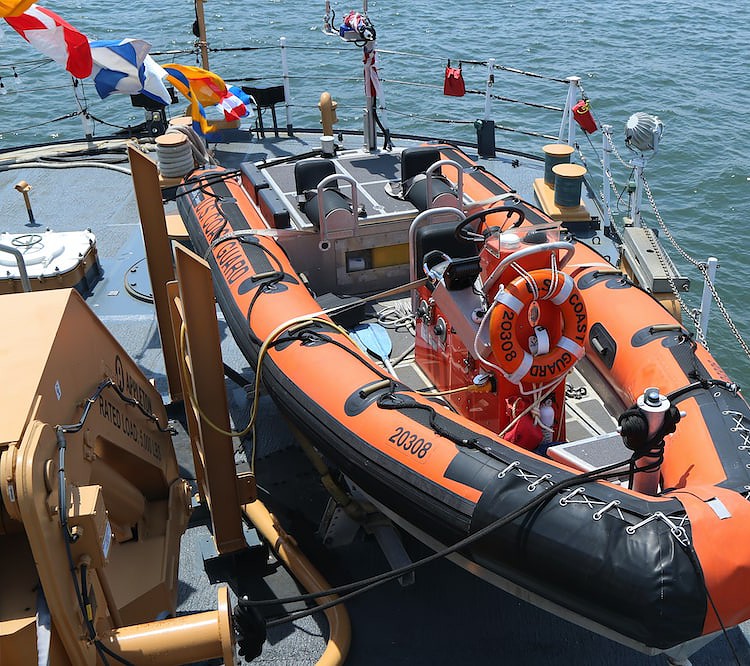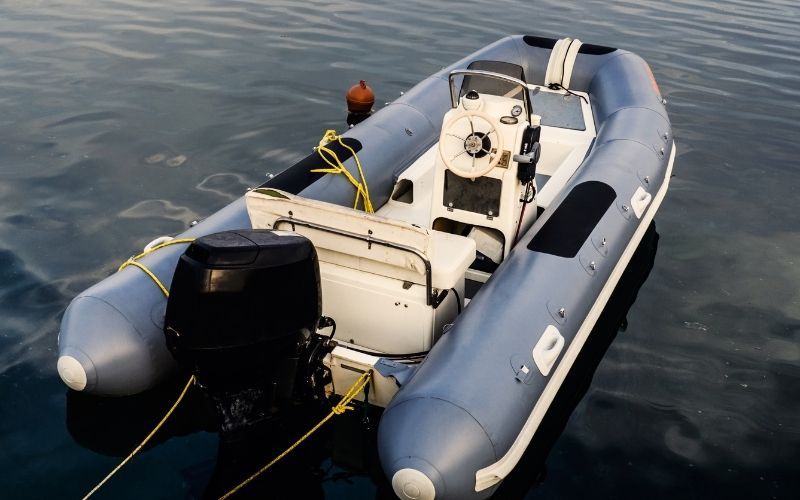What do you get when you mix a heavy-duty fully-solid boat with a lightweight inflatable dinghy?
You get a RIB inflatable boat.
What is a RIB inflatable boat you might ask?
RIBs (Rigid-Hull Inflatable Boats) are boats with a solid hull topped with an inflatable gunwale. This hull is V-shaped and is made from aluminum, steel, fiberglass, or wood. Meanwhile, the sides are inflatable, made from either Hypalon or PVC.
This design is one of the most popular for boats nowadays. You can see them all over the place.
But what’s all the fuss with RIBs?
What are the advantages of RIBs?
And, most importantly, is it worth it for you to buy a RIB?
Today, we’re going to answer all of these questions. This is our ultimate guide to RIB boats.
Table of Contents
What is a RIB?

RIBs are boats that combine the lightweight and convenience of an inflatable boat with the speed and stability of a solid boat. In a lot of ways, they are the middle ground between these two.
RIBs vs Fully Inflatable Boats
So what’s the difference between a RIB and a fully inflatable boat?
For one, RIBs are a lot more sturdy. With their solid hull, they can reach high speeds without flipping over. It can also cut through choppy water without any problems.
If you’ve ridden a fully inflatable boat (such as the Intex Excursion 5), you know that it can only go so fast. It can’t carry heavy engines. And even if it could, there’s a big chance it’ll flip over once it reaches high speeds.
Also, you can’t navigate through big waves in such a lightweight craft. If you try it, the coast guard will have to rescue you before long.
Speaking of weight, fully inflatable boats are a lot lighter than RIBs. They can also be folded up once you are done using them. That’s why when it comes to convenience, nothing beats a full inflatable.
RIBs are heavier, and you can’t fold them up. This makes it a lot more hassle to bring around. To do this, you’ll need a truck and a trailer.
But once it’s on the water, RIBs are a lot more comfortable. Their solid floor is not only more sturdy but it also allows you to install anything to your liking. You can install seats, storage, or even a roof.
Contrast this to the soft air floor of fully inflatable boats, which sinks in whenever you put weight on it. Air floors also have a risk that you’ll puncture it and your boat will sink. With no sturdy floor and no chairs, sitting on these boats can sometimes get uncomfortable.
You get the picture. RIBs are high-performance, but low convenience. On the flip side, full inflatables are not as heavy-duty, but super convenient.
RIBs vs Fully Inflatable Boats
| RIBs | Fully Inflatable Boats |
| High-speed | Can’t go very fast |
| Sturdy and smooth even on rough water | Can’t handle rough water and will flip if going too fast |
| Can install seats, storage, and roof for added comfort | Can’t bring too much on board because of soft air floor |
| Heavy | Lightweight |
| Needs a trailer to bring along | Can be folded and fit into a bag once finished using |
| Quite expensive | Affordable |
RIBs vs Fully Solid Boats
On the other extreme are boats that are fully solid. RIBs are more similar to these types of boats. The only difference is that the gunwales of RIBs are inflatable.
You might be wondering, “What’s the purpose of putting inflatable tubes on top of a solid hull?”
When RIBs first came along, these inflatables were intended to be a cushion for lifeboats. They didn’t want the lifeboats scratching and denting the boats it came alongside, so they added inflatable tubes.

They quickly discovered that this design had lots of other pros.
For one, the inflatable tubes gave them a much smoother ride. This is because the hull could now change shape when it hit the waves. The inflatable tubes acted as a new shock-absorber for these boats.
They also found that this new design was more buoyant. They could load more on their boats, and if ever the hull cracked, the inflatable sides would keep the boat afloat.
What’s more, RIBs were a lot lighter than full solid boats. This made them a lot easier to transport on land. Of course, it wasn’t quite as easy as a full inflatable, but it was a lot less hassle then transporting a full solid.
All of these made the inflatable sides a very popular design. It wasn’t long before RIBs were seen all over the place, in the coast guard, military, and recreational scenes.
Of course, regular boats didn’t disappear. But RIBs certainly changed the landscape (or should we say, seascape) of boating.
What are RIBs used for?
Whether you go to the lake, beach, or ocean, you’re likely to come across some RIBs. The reason these boats are all over the place is that they are very versatile.
Like their original intention, RIBs are still used as lifeboats. Their size, buoyancy, stability, and speed make them one of the best options for emergencies.
But that isn’t the only thing they’re used for. Because the solid floor allows chairs and roofs, RIBs are also used for commercial transport. Whenever passengers or goods need to be ferried over a short distance, RIBs are a great option.

The navy SEALs also use this type of boat. It can handle relatively rough water and can get them to their destination fast. They can also install equipment, such as machine guns, on the hull, making them more effective at their missions.
Finally, RIBs are also perfect for recreation. Yes, RIBs are great as workboats, but that doesn’t mean it’s all work and no play.
Whether you’re going fishing, diving, or exploring, RIBs will have everything you need. They are spacious and sturdy, so you can bring along lots of gear. Plus, the whole family can ride along.
That’s why RIBs are one of the top types of recreational boats. Yes, they’re more expensive than fully inflatable boats. But for a lot of people, they are well worth the money. Besides, it’s not like they cost as much as a yacht.
How Safe are RIBs?

Whenever you’re out on the water, safety should always be the number one priority. Thanks to RIBs solid hull and inflatable sides, it is super safe. Sinking is one of the last things you have to worry about when you’re on this type of boat.
This is because if either the hull or the inflatables fail, the other will hold the boat up. If water is coming in the hull, the inflatable sides will keep the boat afloat. In the same way, if the inflatable tubes get punctured, the hull is enough to stay above water.
Contrast this to full inflatable boats where a puncture can spell doom. Or full solid boats where a single crack in the hull can bring the whole boat down.
Furthermore, the shock-absorbing properties of this design not only give a smoother ride, but also less risk of capsizing. Since the hulls shapeshift to the waves beneath it, RIBs can go on rather rough water. This way, the boat never tilts too much on any side, making it much safer.
What’s more, the inflatable material also lasts for a long, long time. If you’re wondering, “how long do RIB tubes last?” The answer is around 20 years. If you take good care of your RIB and clean it regularly, it will last you even longer than that.
Overall, RIBs are very safe. They are a lot safer than, say, a full inflatable.
That said, RIBs are not invincible. Yes, they can handle rough water, but we’re not talking about the open-ocean type of rough water. Don’t complain if your RIB capsizes while riding a tsunami.
Also, it’s not wise to use a RIB if either the hull or inflatable sides are compromised. It’ll float, but you should repair it as soon as you get to shore.
What to Look for When Buying a RIB
So you’ve decided to buy a RIB. You search online for RIB dealers nearby, but then you run into a problem…
You don’t know what you’re looking for.
There are so many RIBs in the market nowadays. So many, choosing the perfect RIB for yourself will take some work. If you don’t know what you’re looking for, you can go round and round and end up with a poor boat.
But don’t worry, because we’re here to help. When buying a RIB, you should consider a few things. These are:
- Purpose
- Hull-Shape
- Water Shedding
- Features
- Documents
Purpose
Before you head to the store or search online, it’s important to know what you’ll use your RIB for. Are you going fishing? Diving? Are you going to use it on a river, lake, or the ocean?
You should also consider how many people you plan to bring along. Will you go on a solo trip? Is the whole gang coming with you?
RIBs come in all shapes and sizes. There’s family size, solo size, and there’s also RIBs built especially for lakes or for the sea.
That’s why knowing what you’ll do with your RIB is so important. This way, you can get the perfect one for you.
Hull-Shape
RIBs are known for their V-shaped bottom. The depth of that V differs from boat to boat though. It’s another thing you should look at when buying a RIB.
It goes back to your intended use. Do you want to speed across the waves? Or are you looking for a more chill day at the lake?
If you want the high-performance, jumping over the waves boat, get one with a deep V. This shape allows the boat to cut through the waves with ease because of its shape. The ride will be a lot smoother since the hull won’t be slamming against the surface after jumping every wave.
On the flip side, if you’re looking for a casual fishing trip in steady waters, you may want a flatter hull. When the boat isn’t going at high speed, a deep V can sometimes feel unsteady. Flatter hulls are better for when you want to relax because they’re more stable when not moving.
Water Shedding
When you run your RIB at full speed, you can expect to get wet. Sure, it’ll be a smooth ride, but expect splashes of water to hit you every now and then.
A good RIB will never fill with water this way. They’re built in a way that if ever water gets in, it will always shed out. So no matter how much water splashes in, you shouldn’t have to worry.
That’s why you should check the shedding system in the RIB. A poor shedding system won’t sink you. But who wants a puddle of water inside their boat?
Another thing to look for in your potential RIB is dry space. Because there’s going to be a lot of splashing, you should check whether there is any place that stays completely dry. This way your bags and other items won’t get soaked on your trip.
Features
Every RIB comes with a bunch of features for you. These may include seats, storage, roofs, and more. A lot of RIBs also come with pre-installed engines. (Keep in mind that you do want an engine since most RIBs are very difficult to paddle. If your dealer doesn’t have one, you can always buy elsewhere)
Think about the things you’d like from your boat before you buy one. This will save you a lot of time sorting through different boats with different features. If you know what you’re looking for, you can find it a lot quicker.
You should also keep in mind how powerful of an engine you need. For speeding through the water, you need high horsepower. But for calm and relaxing trips, you’ll only need a few.
Documents
Let’s say you’ve found the perfect boat. It fits your needs perfectly, it has the right shape, sheds water well, and has a bunch of good features… what else are you waiting for?
But before you buy it, there’s one more thing to check. That is the boat’s papers.
Your boat may look great, but you may encounter problems once you hit the water. If you can’t test drive the boat before buying, make sure it has a good warranty. RIBs are not cheap, the last thing you want is to spend money on a broken boat.
You also want to check the registration. If you buy a new boat, the company should help you get it registered. If you buy second-hand, you should ask for all the details and papers on this.
This is very important since RIBs have motors on them. If you have a look at state laws, you’ll find that almost every state requires these to be registered.
With all those in mind, you should end up with the perfect RIB.
Conclusion
Now you know what’s up. Now you know why RIBs are all over the place. Whenever there’s water, there seems to be a RIB around.
Should you buy one? That’s completely up to you.
But if you’re looking for a boat that’s fast and sturdy…
…that has a lot of room and is very comfortable
…that is safe even when conditions get a bit rough
…that is perfect for fishing, diving, and exploring
…that has a high-performance yet isn’t too expensive
If you’re looking for a boat with all of these, RIBs are your best bet.

I created this site to help people – to help you – with your boat problems. Instead of helping one person at a time, I want this website to be the “one-stop-shop” for everyone’s boating concerns. Read more.

